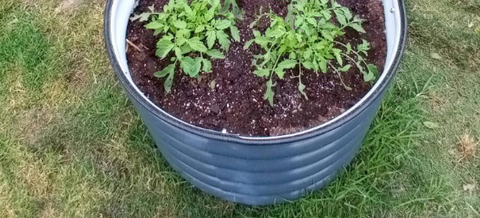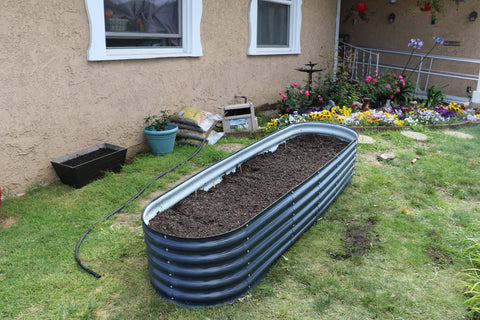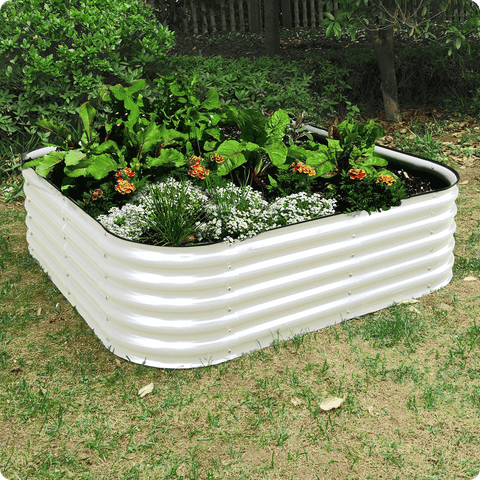Knowledge from Olle Garden Bed: How to Refresh Garden Soil
The soil is used not only for horticulture, but also for all kinds of agriculture. The best soil for most plants is moist, well-drained loam, which is the perfect balance of sand, silt, and clay. But even loam will begin to suffer. Plants eventually run out of nutrients, and unless new organic matter is introduced, there isn't much to feed earthworms or beneficial microorganisms. Here's how to modify your garden bed soil in the fall to encourage your garden to bounty for the next season.

Add compost
Compost is the best organic matter you can introduce into your soil – this applies to any soil, from clay to sand. Soil with too much clay is poorly drained because fine soil particles stick together, making it harder for air to reach plant roots. Compost breaks down sticky substances. Compost also helps sandy soils retain water and nutrients that would otherwise leach quickly from the porous soil. To add compost to your garden, place it 2 to 3 inches on top of the garden bed.
Add leaves
To learn how to renew the soil in the garden, take a page from the nature manual and add organic matter. This is what nature does every autumn when the leaves fall. The trouble is, most of us keep this bounty on the side of the road.
Instead, bag leaves are kept handy to add to your compost pile. Carbon-rich leaves balance kitchen residue high in nitrogen for faster composting. You can also chop the leaves with a chipper, shredder or mulch mower and spread the wreckage in the garden. These broken leaves break down faster – and they're less likely to be blown away by the wind.
Or try digging up leaves in the vegetable garden in the fall. Some leaves are more suitable for this than others. Silver maple leaves almost disappear in late spring, while harder oak leaves tend to decompose slowly. Use oak leaves as mulch as they can last until the next summer when mulch is most needed. Just make sure to chop them up first, as the whole leaf will form a mat that water cannot penetrate. (Never use walnut leaves, which contain a substance called juglone that can kill or damage plants.)
By scattering leaves in the garden bed in autumn, you can give butterfly eggs or larvae a place to wait for winter, ensuring a new generation. In addition, scattering the leaves after the ground freezes prevents perennials from frost heaving in the winter while slowly decomposing and feeding the soil.

Ruth Stott method
Another way to renew the soil is the Ruth Stott method, named after a popular garden writer who wrote a series of books on no-till gardening half a century ago. Stout "covered in place", that is, she piled straw, leaves, garden debris and other organic materials around the vegetables to let nature run its course.
Using the Ruth Stout method in the vegebed and natural shrub boundary is convenient because you don't have to bag newspaper clippings or leaves, flip the compost pile, plow the soil, or weed the bed. Plants need less watering, and there are earthworms that do what they do best in large numbers: aerate the soil and fertilize it with their castings. However, if you encounter any diseased plants in your garden, you will need to remove them, in which case this method is not so suitable.
Test soil pH
While the above methods will gradually improve the soil, it is worth testing the soil so you can better understand what is being used. Soil test kits tell you how much your soil is pH (a measure of acidity versus alkalinity) and whether your soil needs one or more of the three main macronutrients (nitrogen, phosphorus, and potassium). Soil pH is important for several reasons. Most plants prefer neutral to slightly acidic soils (pH of 5.5 to 7.0), so higher or lower levels will attract fewer plants. In addition, some nutrients are not available at higher or lower pH, so they end up looking pale and sick.
Once you know the pH of the soil, you can change it as needed. Add garden sulfur to lower the pH or garden lime to make the soil more alkaline. The amount you need to add will depend on the type of soil; Follow the instructions on the package.
Tillage the soil
In addition to organic matter, nutrients, and pH, another factor that can affect soil health is compaction. This is especially noticeable on clay that is trampled on when wet. This destroys the soil structure, making it harder for water, nutrients and air to reach plant roots.
Tillage can help if not tilled regularly – not season after season, which can cause powdery soil to scab and repel water. Farming can be hard work, so there's no shame in asking a wheelmaker to help along the way. Another option is double mining. Remove a row of soil, dig about 1 foot deep and keep the excavated soil. Before moving on to the next row, use a fork to loosen the hard pan (a tight subsoil that is lighter in color than the topsoil you just removed). Again, dig 1 foot down, this time putting the excavated soil into the first ditch. Loosen the subsoil of the second row and continue to the third row. Repeat the process until you reach the end of the bed and fill the last ditch with the retained soil.

Finally, the easiest way to do this is probably to build a raised garden bed and fill it with a 1:1 mix of quality garden soil and compost. Raised beds have several benefits: you never step into them, so the soil doesn't become compacted. In addition, the bed can work earlier in the spring than the ground garden bed. Finally, you can create any blend you like – without making large-scale changes to the floor bed
